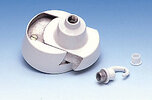- Joined
- 12 Mar 2016
- Messages
- 342
- Reaction score
- 2
- Country

Hi all
Juat wondering should I turn of the circuit breaker for the lights when changing a lightbulb?
If so should I turn off just the breaker for the lights or shut down the whole fuse box?
Juat wondering should I turn of the circuit breaker for the lights when changing a lightbulb?
If so should I turn off just the breaker for the lights or shut down the whole fuse box?

